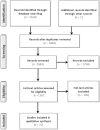Factors and models associated with the amount of hospital care services as demanded by hospitalized patients: a systematic review
- PMID: 24878506
- PMCID: PMC4039449
- DOI: 10.1371/journal.pone.0098102
Factors and models associated with the amount of hospital care services as demanded by hospitalized patients: a systematic review
Abstract
Background: Hospitals are constantly being challenged to provide high-quality care despite ageing populations, diminishing resources, and budgetary restraints. While the costs of care depend on the patients' needs, it is not clear which patient characteristics are associated with the demand for care and inherent costs. The aim of this study was to ascertain which patient-related characteristics or models can predict the need for medical and nursing care in general hospital settings.
Methods: We systematically searched MEDLINE, Embase, Business Source Premier and CINAHL. Pre-defined eligibility criteria were used to detect studies that explored patient characteristics and health status parameters associated to the use of hospital care services for hospitalized patients. Two reviewers independently assessed study relevance, quality with the STROBE instrument, and performed data analysis.
Results: From 2,168 potentially relevant articles, 17 met our eligibility criteria. These showed a large variety of factors associated with the use of hospital care services; models were found in only three studies. Age, gender, medical and nursing diagnoses, severity of illness, patient acuity, comorbidity, and complications were the characteristics found the most. Patient acuity and medical and nursing diagnoses were the most influencing characteristics. Models including medical or nursing diagnoses and patient acuity explain the variance in the use of hospital care services for at least 56.2%, and up to 78.7% when organizational factors were added.
Conclusions: A larger variety of factors were found to be associated with the use of hospital care services. Models that explain the extent to which hospital care services are used should contain patient characteristics, including patient acuity, medical or nursing diagnoses, and organizational and staffing characteristics, e.g., hospital size, organization of care, and the size and skill mix of staff. This would enable healthcare managers at different levels to evaluate hospital care services and organize or reorganize patient care.
Conflict of interest statement
References
-
- Needleman J, Buerhaus P, Pankratz VS, Leibson CL, Stevens SR, et al. (2011) Nurse staffing and inpatient hospital mortality. N Engl J Med. 364(11): 1037–45. - PubMed
-
- Parikh A, Huang SA, Murthy P, Dombrovskiy V, Nolledo M, et al. (2012) Quality improvement and cost savings after implementation of the Leapfrog intensive care unit physician staffing standard at a community teaching hospital. Crit Care Med 40(10): 2754–9. - PubMed
-
- Dubois C, d'Amour D, Tchouaket E, Clarke S, Rivard M, et al. (2013) Associations of patient safety outcomes with models of nursing care organization at unit level in hospitals. Int J Qual Health Care 25(2): 110–7. - PubMed
-
- Mainz J (2013) Defining and classifying clinical indicators for quality improvement. Int J Qual Health Care 15(6): 523–30. - PubMed
-
- Fries JF, Koop CE, Sokolov J, Beadle CE, Wright D (1998) Beyond health promotion: reducing need and demand for medical care. Health Affairs 17: 70–84. - PubMed
Publication types
MeSH terms
LinkOut - more resources
Full Text Sources
Other Literature Sources
Medical
Miscellaneous


